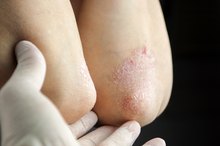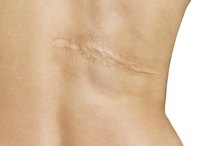How to Restore the Pigment to White Spots on the Skin
White spots on the skin are a result of hypopigmentation, which means that the skin cells are lacking and not producing melanin, a pigment responsible for skin color. Hypopigmentation can be more difficult to treat than hyperpigmentation, a condition of dark spots caused by an abundance of melanin, but some methods may restore the natural skin color.
Consult a dermatologist. If the white spots are not caused by scarring, a dermatologist can identify the condition, its cause and available treatments. Some white spots on the skin are caused by medical conditions. These include vitiligo, which causes a complete loss of pigment; pityriasis versicolor, a chronic fungal condition, and pityriasis alba, a form of eczema.
What Are the Causes of White Spots on Tan Skin?
Learn More
Avoid exposure to the sun. If the white spot is located in a sun-exposed area such as the face, neck or hands, use a high-strength sunscreen. Patients often think that exposing the white area to the sun will darken it. But the sun will increase the contrast between the spot and the normal skin and ultimately will cause more damage.
Don't look for quick fixes. For white spots to return to normal color, the cells that aren't producing melanin need to be replaced with normal, healthy cells. The key is to trigger a healthy functioning of cells, which is a process. Simply lathering on a substance with a dye effect will do nothing to change the condition. However, you can try a tinted cosmetic cream such as a self-tanner to camouflage the spots while you're getting other treatments.
Can You Restore the Pigment to White Spots on the Skin?
Learn More
Ask your doctor about prescription steroid creams. They are the safest and simplest initial treatment, especially for vitiligo that is recently diagnosed or spreading. These creams may be used to treat other cases of moderate to severe hypopigmentation. The creams provoke the skin to produce melanocytes, which are cells that create melanin. The creams require multiple daily applications for three to six months. Side effects vary by brand and patient.
Purchase antifungal creams if you have pityriasis versicolor. This is a common skin condition caused by an infection of dead surface skin cells with a yeast fungus, which typically begins on the back. An antifungal cream can get rid of the yeast and restore skin color within weeks once the dead cells are shed, according to BBC Health.
Address the root of the eczema problem if that is causing the white spots. There are many types of eczema, all of which require different, specific treatments. Your dermatologist can diagnose and treat the eczema type. When the eczema is under control, ask your dermatologist about correcting residual hypopigmentation.
Consider PUVA therapy, a combination of the oral drug psoralen and a high-intensity long-wave ultraviolet light. This is a common treatment for vitiligo patients. The American Osteopathic College of Dermatology reports that PUVA is effective in restoring some color in more than half of treated patients, but total restoration of color occurs in only 15 percent to 20 percent of patients. Treatment sessions are two or three times weekly. Even if they work, you probably won't see results for at least a few months.
Ask your dermatologist about laser resurfacing. A Dermatology News report on SkinTherapyLetter.com indicates that this treatment is effective for correcting hypopigmentation, including white spots on the delicate skin of the face. This is ironic given that white spots are a side effect of a cosmetic laser-resurfacing procedure used on dark-skinned patients.
Related Articles
References
- Vashi NA, de Castro Maymone MB, Kundu RV. Aging differences in ethnic skin. J Clin Aesthet Dermatol. 2016;9(1):31-38.
- American Osteopathic College of Dermatology. Hyperpigmentation.
- Bandyopadhyay D. Topical treatment of melasma. Indian J Dermatol. 2009;54(4):303-309. doi:10.4103/0019-5154.57602
- Kang SJ, Choi BR, Lee EK, et al. Inhibitory effect of dried pomegranate concentration powder on melanogenesis in B16F10 melanoma cells; involvement of p38 and PKA signaling pathways. Int J Mol Sci. 2015;16(10):24219-42. doi:10.3390/ijms161024219
- Parveen R, Akhtar N, Mahmood T. Topical microemulsion containing Punica granatum extract: its control over skin erythema and melanin in healthy Asian subjects. Postepy Dermatol Alergol. 2014;31(6):351-5. doi:10.5114/pdia.2014.47117
- Kim E, Hwang K, Lee J, et al. Skin protective effect of epigallocatechin gallate. Int J Mol Sci. 2018;19(1). doi:10.3390/ijms19010173
- Kim YC, Choi SY, Park EY. Anti-melanogenic effects of black, green, and white tea extracts on immortalized melanocytes. J Vet Sci. 2015;16(2):135-43. doi:10.4142/jvs.2015.16.2.135
- Zhou BR, Ma LW, Liu J, et al. Corrigendum to "protective effects of soy oligopeptides in ultraviolet B-induced acute photodamage of human skin". Oxid Med Cell Longev. 2018;2018:3871280. doi:10.1155/2016/5846865
- Adhikari D, Panthi VK, Pangeni R, Kim HJ, Park JW. Preparation, characterization, and biological activities of topical anti-aging ingredients in a Citrus junos callus extract. Molecules. 2017;22(12). doi:10.3390/molecules22122198
Writer Bio
Isobel Washington has been a freelance journalist since 2007. Washington's work first surfaced in Europe, where she served as a restaurant critic and journalist for "LifeStyles" magazine. Her love of travel and culture inspired her first novel, which is currently underway. Washington has a 10-year career in marketing communication and holds a Bachelor of Science degree.








